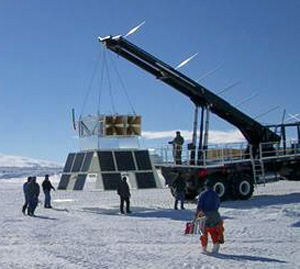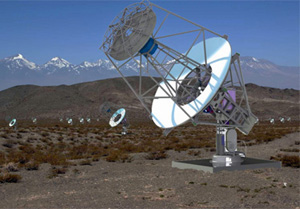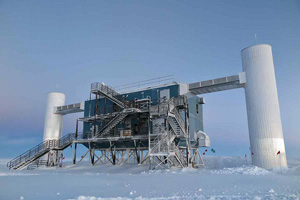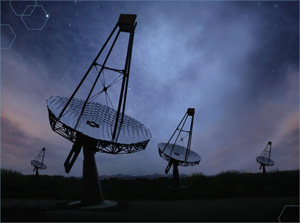High-energy gamma ray and neutrino experiments
 ANITA is a balloon-borne experiment designed to
fly over Antarctica to study cosmic UHE neutrinos. Cosmic neutrinos are generated in the collisions between
cosmic rays and the universe's microwave photon background at incredible energies that could never be reached
on Earth. They therefore provide an exciting window into very high energy physical phenomena like the generation
of micro-black holes and other exotic occurances that could demonstrate the unity of forces in the universe.
ANITA is a balloon-borne experiment designed to
fly over Antarctica to study cosmic UHE neutrinos. Cosmic neutrinos are generated in the collisions between
cosmic rays and the universe's microwave photon background at incredible energies that could never be reached
on Earth. They therefore provide an exciting window into very high energy physical phenomena like the generation
of micro-black holes and other exotic occurances that could demonstrate the unity of forces in the universe.
 CTA (Cherenkov Telescope Array is the major
ground-based gamma-ray observatory planned for the next decade and beyond. CTA will consist of two large arrays
of atmospheric Cherenkov telescopes, located at La Palma (Spain) in the north and at Paranal
(Chile) in the south.
CTA (Cherenkov Telescope Array is the major
ground-based gamma-ray observatory planned for the next decade and beyond. CTA will consist of two large arrays
of atmospheric Cherenkov telescopes, located at La Palma (Spain) in the north and at Paranal
(Chile) in the south.
With a wider energy range, improved angular resolution, and much better sensitivity than existing telescopes (HESS, MAGIC or VERITAS), CTA will be the premier instrument to explore the high-energy non-thermal universe and to search for particle dark matter at the TeV mass scale.
 IceCube is the world's largest experiment to
detect high-energy and very high-energy neutrinos. Located at the South Pole and consisting of a 1 km^3 volume of
ice instrumented by 1600 digital optical modules, IceCube is sensitive to atmospheric and astrophysical neutrinos
ranging in energy from 10 GeV to many PeV.
IceCube is the world's largest experiment to
detect high-energy and very high-energy neutrinos. Located at the South Pole and consisting of a 1 km^3 volume of
ice instrumented by 1600 digital optical modules, IceCube is sensitive to atmospheric and astrophysical neutrinos
ranging in energy from 10 GeV to many PeV.
 VERITAS (Very Energetic Radiation Imaging Telescope Array System)
is a state-of-the-art ground-based gamma-ray observatory. VERITAS uses an array of four large atmospheric Cherenkov
telescopes to achive unprecedented sensitivity to sources of gamma rays in the energy range between 50 GeV and 50 TeV.
VERITAS (Very Energetic Radiation Imaging Telescope Array System)
is a state-of-the-art ground-based gamma-ray observatory. VERITAS uses an array of four large atmospheric Cherenkov
telescopes to achive unprecedented sensitivity to sources of gamma rays in the energy range between 50 GeV and 50 TeV.
Located on Mt. Hopkins in southern Arizona, USA, the array became fully operational in 2007 and is now carrying out a full observing program and is producing a wide range of astrophysical results.